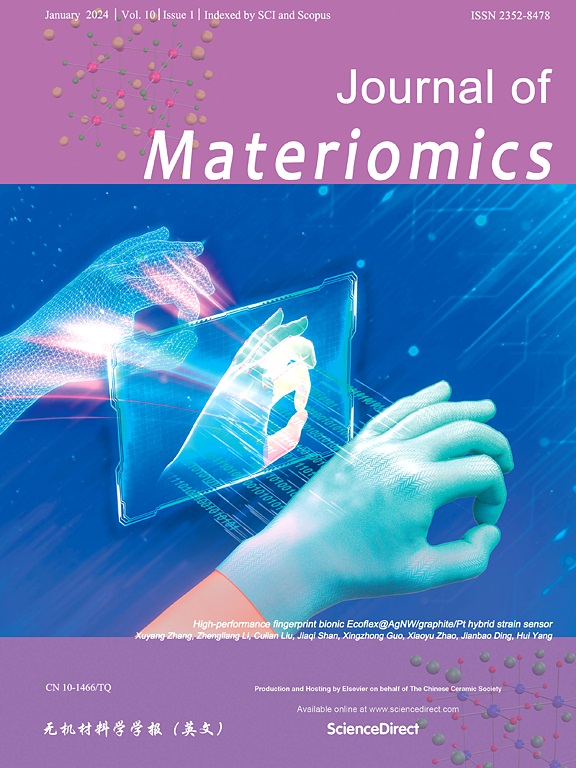Ultra-high energy storage density and efficiency at low electric fields/voltages in dielectric thin film capacitors through synergistic effects
IF 8.4
1区 材料科学
Q1 CHEMISTRY, PHYSICAL
引用次数: 0
Abstract
Ensuring reliable and safe operation of high-power electronic devices necessitates the development of high-quality dielectric nano-capacitors with high recoverable energy density (URec) and efficiency (η) at low applied electric fields (E)/voltages. In this work, we demonstrate ultra-high URec and η at low E < 500 kV/cm in as-grown epitaxial relaxor ferroelectric (RFE) PMN-33PT films, rivaling those typically achieved in state-of-the-art RFE and antiferroelectric (AFE) materials. The high energy storage properties were achieved using a synergistic strategy involving large polarization, a giant built-in potential/imprint (five times higher than the coercive field), and AFE like behavior. The structural, chemical, and electrical investigations revealed that these achievements mainly arise from the effects of strain, dipole defects, and chemical composition. For instance, at low E, the capacitors exhibit under 160 kV/cm (i.e., 8 V) and 400 kV/cm (i.e., 20 V), respectively, an ultra-high ΔP (45 μC/cm2 and 60 μC/cm2), UE= URec/E (21 J⸱MV/cm2 and 17 J⸱MV/cm2), and UF=URec/(1–η) (20 J/cm3 and 47 J/cm3) with a robust charge-discharge fatigue endurance and outstanding frequency and thermal stability. Additionally, the designed films exhibit outstanding energy storage performance at higher E up to 2 MV/cm (ΔP ≈ 78 μC/cm2, UE ≈ 17.3 J⸱MV/cm2 and UF ≈ 288 J/cm3) due to their low leakage current density.


基于协同效应的介质薄膜电容器在低电场/电压下的超高能量存储密度和效率
为了保证大功率电子器件的可靠和安全运行,需要开发高质量的介质纳米电容器,该电容器在低外加电场(E)/电压下具有高可回收能量密度(URec)和高效率(η)。在这项工作中,我们在生长的外延弛豫铁电(RFE) PMN-33PT薄膜中展示了在低E <;500 kV/cm下的超高URec和η,可与最先进的RFE和反铁电(AFE)材料相匹敌。高能量存储性能是通过协同策略实现的,包括大极化、巨大的内置电位/印记(比矫顽力场高5倍)和AFE类行为。结构、化学和电学研究表明,这些成就主要是由于应变、偶极子缺陷和化学成分的影响。例如,在低E时,电容器分别在160 kV/cm(即8V)和400 kV/cm(即20V)下表现出超高的ΔP (45 μC/cm2和60 μC/cm2), UE= URec/ E (21 J⸱MV/cm2和17 J⸱MV/cm2), UF=URec/(1 - η) (20 J/cm3和47 J/cm3),具有良好的充放电疲劳耐久性和出色的频率和热稳定性。此外,由于所设计的薄膜具有较低的漏电流密度,在较高的E下具有优异的储能性能,最高可达2 MV/cm (ΔP≈78 μC/cm2, UE≈17.3 J⸱MV/cm2, UF≈288 J/cm3)。
本文章由计算机程序翻译,如有差异,请以英文原文为准。
求助全文
约1分钟内获得全文
求助全文
来源期刊

Journal of Materiomics
Materials Science-Metals and Alloys
CiteScore
14.30
自引率
6.40%
发文量
331
审稿时长
37 days
期刊介绍:
The Journal of Materiomics is a peer-reviewed open-access journal that aims to serve as a forum for the continuous dissemination of research within the field of materials science. It particularly emphasizes systematic studies on the relationships between composition, processing, structure, property, and performance of advanced materials. The journal is supported by the Chinese Ceramic Society and is indexed in SCIE and Scopus. It is commonly referred to as J Materiomics.
 求助内容:
求助内容: 应助结果提醒方式:
应助结果提醒方式:


